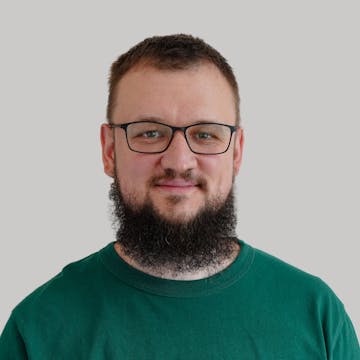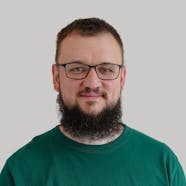When it comes to maximizing revenue for your SaaS business, choosing the right pricing strategy is critical. With various models available, the key is understanding how each model works, its effectiveness, and how it aligns with your product and customer base.
Whether you're a startup looking to attract your first customers, finding the right pricing strategy can make all the difference in driving growth and profitability.
This article will explore different SaaS pricing strategies, backed by data and real-world examples, and guide on selecting the best approach for your specific SaaS product.
Difference between pricing strategy and pricing model
Pricing strategy is the overarching approach to evaluate your product or service. It involves considering factors like target market, value proposition, competition, and costs. More than just setting a price, a strong pricing strategy involves long-term planning that aligns with your business objectives. It helps ensure your product remains competitive while maximizing profitability and supporting growth over time.
The pricing model is the specific structure or format of your pricing. It determines how customers will pay, such as subscription-based, usage-based, or flat-rate.
In essence, pricing strategy is the "why" behind your pricing, while the pricing model is the "how."
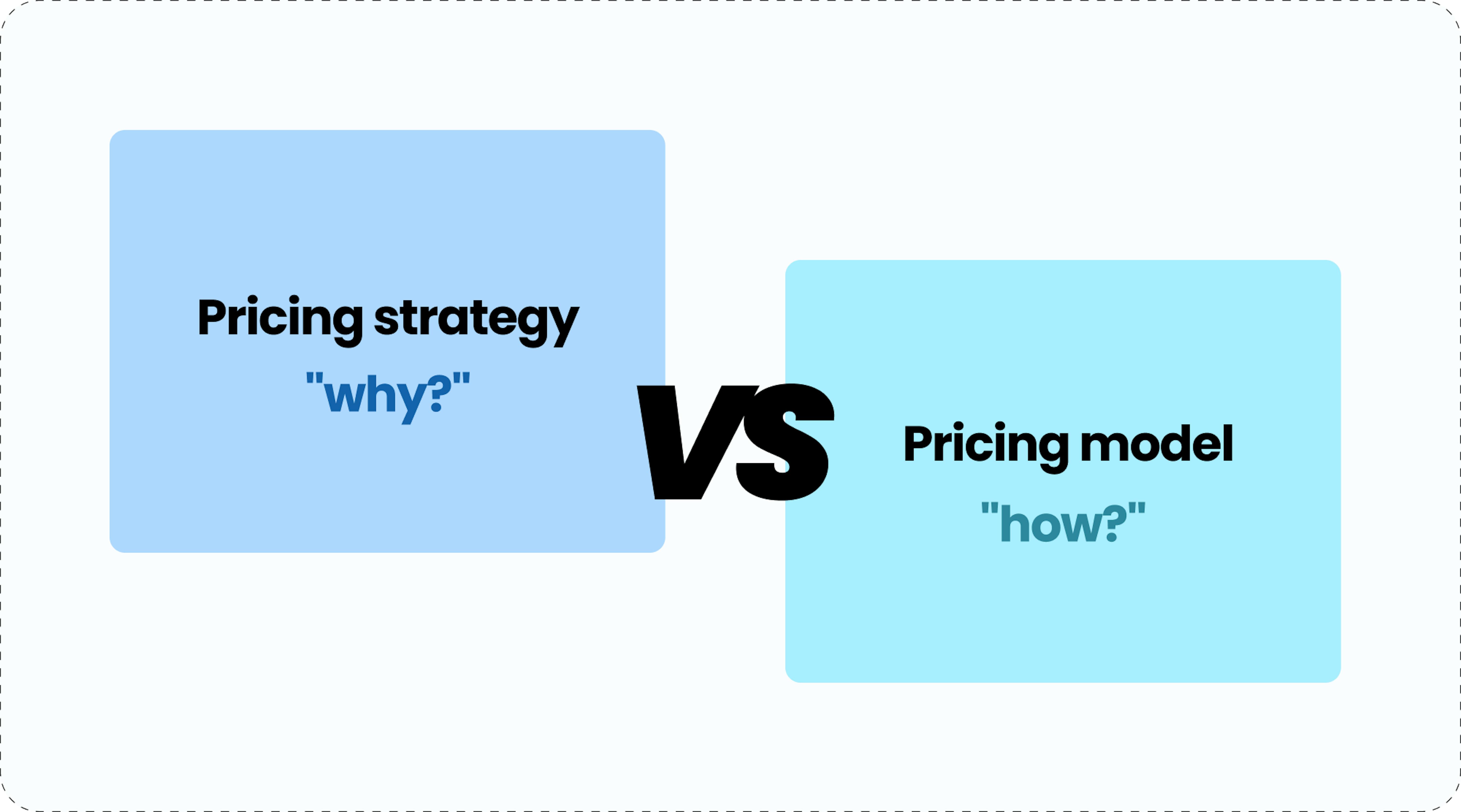
How is SaaS pricing different?
In a subscription-based pricing model, customers pay regularly to continue using a service or product. Unlike traditional product pricing, where customers typically make a one-time purchase, subscription-based SaaS pricing involves recurring payments. This means SaaS companies must continuously deliver value to retain customers over time. With traditional products, the sales cycle ends after purchase, but with SaaS, pricing must reflect ongoing usage, customer support, feature updates, and scalability. Therefore, SaaS pricing strategies are more dynamic, as they must balance customer satisfaction, retention, and long-term revenue growth while offering flexible packages that adapt to different business needs.
Main factors for SaaS pricing strategy
Setting the right pricing strategy for a SaaS product is essential for ensuring profitability, growth, and customer satisfaction. Various internal and external factors must be considered when developing a pricing strategy.
Below are some of the key factors to guide your approach:
Company size: The size and maturity of your business influence pricing. Established companies can leverage brand recognition and loyalty, whereas newcomers might adopt lower pricing to attract initial customers.
Competitors: Analyzing competitors' pricing and offerings is crucial. If competitors provide similar features, you may need to differentiate through price or value. If you're offering unique features, you might be able to charge a premium.
Business goals: Your pricing strategy should align with your objectives. If you aim for rapid customer acquisition, lower pricing or freemium models might be appropriate. For maximizing revenue, premium pricing for advanced features may work better.
Value proposition: Clearly identifying what makes your SaaS product stand out (innovative features, superior user experience, integrations, etc.) helps in justifying a price point. Customers will pay more if they see distinct value.
Buyer persona: Understanding your target audience's purchasing behavior and pain points helps tailor pricing. Different customer segments might prefer different pricing models—small businesses may prefer pay-per-use, while larger enterprises may opt for subscriptions.
Cloud vs. On-premise: The deployment method greatly influences pricing. Cloud solutions often follow a subscription model, with costs spread over time, making them appealing for businesses seeking lower upfront costs. On-premise solutions usually involve higher initial costs but provide long-term control, which may appeal to larger enterprises.
Cost structure: Your internal costs, including development, infrastructure, support, and ongoing updates, play a role. The pricing should cover these while also generating profit.
Scalability and usage tiers: Pricing should reflect scalability, offering different tiers based on usage or features. Flexible pricing models (e.g., per-user or per-feature) can make the product more attractive to different customer segments.
Factoring these into your strategy can help you strike a balance between customer expectations, market conditions, and profitability.
SaaS pricing strategy types
Here's an overview of various SaaS pricing models, their effectiveness, examples of successful implementations, and recommendations for their use:
Flat-rate pricing
Customers pay a fixed monthly or annual fee for access to a single version of the product with a standard set of features. This model is simple and easy to understand.
Effectiveness:
Flat-rate pricing works well for straightforward products with a clear value proposition. However, it may limit revenue potential as all customers pay the same amount, regardless of their usage or needs.
According to a 2023 SaaS pricing report, flat-rate pricing can lead to underpricing or overpricing, with only 30% of SaaS companies using it successfully.
Pitfalls: Flat-rate pricing can limit revenue growth by not accounting for customers willing to pay more for additional features or usage. It may also deter smaller customers who find the price too high, even if they only need basic functionality.
Successful example: Basecamp charges a flat rate per month, regardless of user count, making it straightforward and appealing for small teams.
Best for Simple SaaS products with a wide target audience, where the value is uniform across all users, such as productivity tools or basic CRM systems.
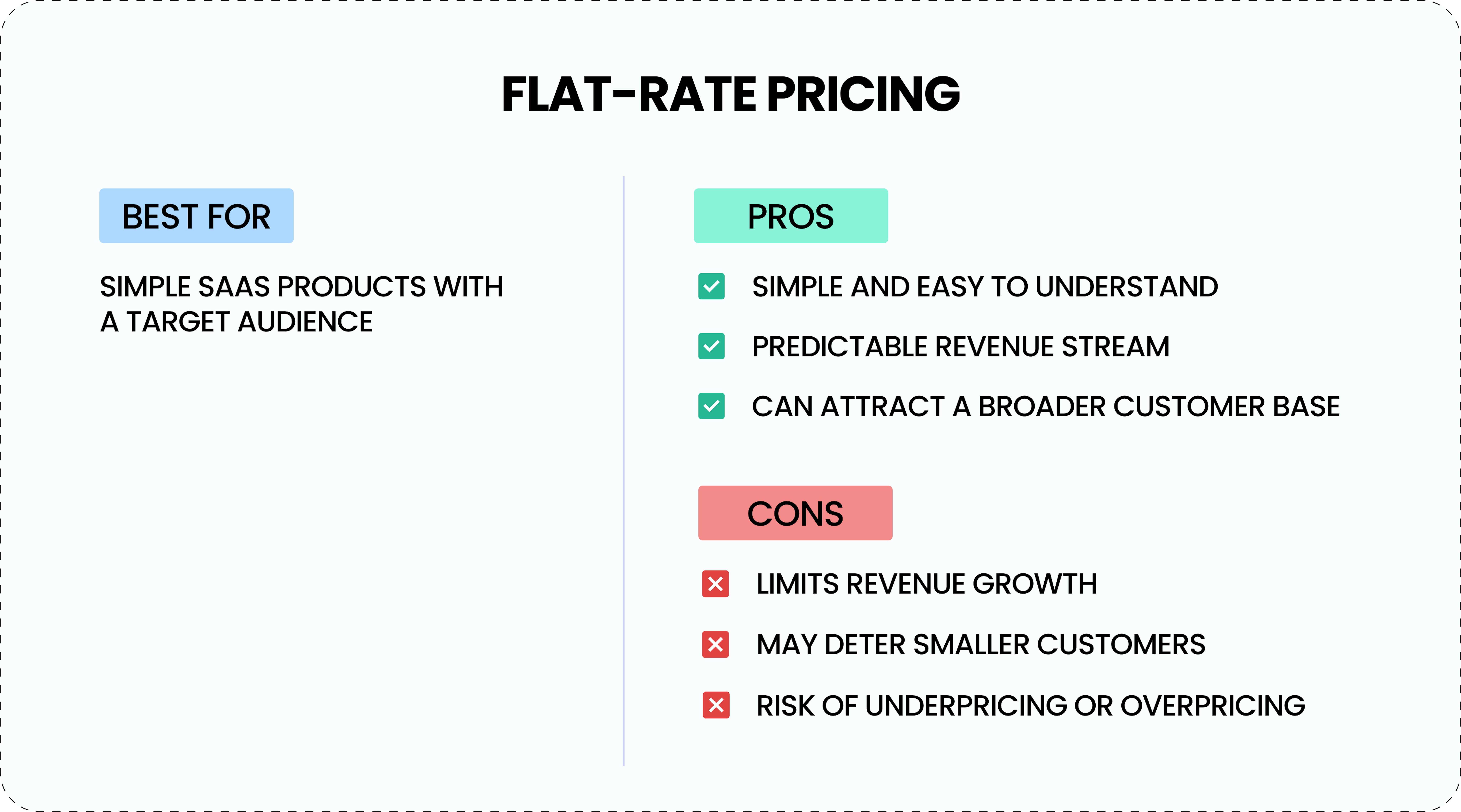
Usage-based pricing (Pay-as-You-Go)
Customers are charged based on how much they use the product, such as the number of users, transactions, or data volume.
Effectiveness:
This model aligns pricing with value delivered, which can be highly effective for maximizing revenue and customer satisfaction.
According to a 2022 OpenView report, companies using usage-based pricing saw a 32% higher growth rate than those using other models.
Successful example: AWS (Amazon Web Services) charges customers based on resources consumed, making it scalable for companies of all sizes.
Pitfalls: Predictable revenue can be challenging with this model, wildly if customer usage varies significantly over time. It can also cause billing confusion if customers don't fully understand how usage is tracked, leading to dissatisfaction.
Best for SaaS products with variable usage patterns, such as cloud services, data storage, and analytics tools, where costs can be tied directly to usage.
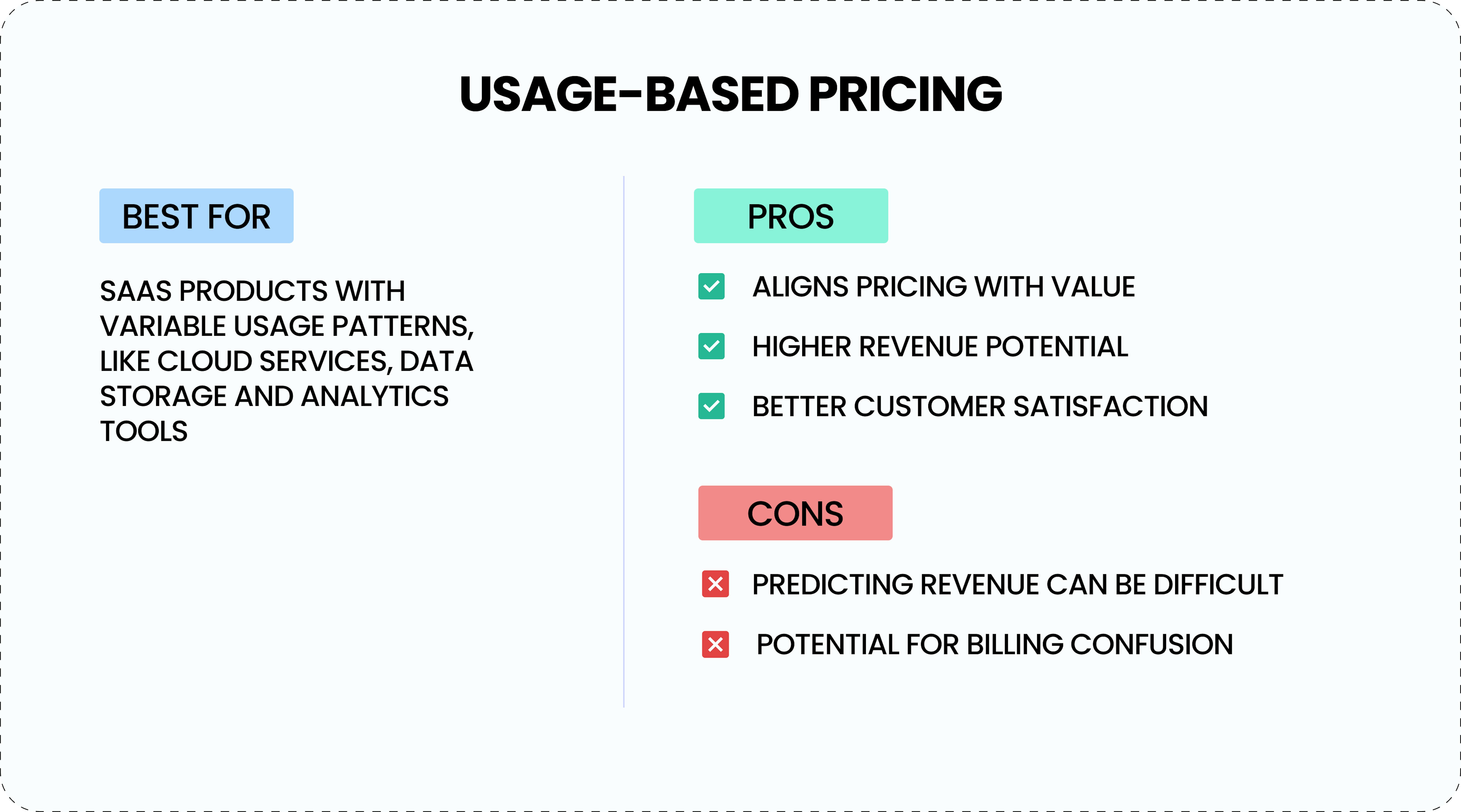
Tiered pricing
This model offers multiple pricing tiers, each with a different set of features, usage limits, or support levels. Customers can choose a tier that best fits their needs and budget.
Effectiveness:
Tiered pricing is highly effective for capturing a wide range of customer segments, from small businesses to large enterprises. It's versatile and can maximize revenue by offering value at different price points.
According to the SaaS Pricing Strategy Guide, 54% of SaaS companies use tiered pricing to cater to different customer needs and willingness to pay.
Successful example: Atlassian (Jira) provides several tiers, from small teams to large enterprises, each with feature enhancements and support levels.
Pitfalls: Poor tiering can lead to lost opportunities—if tiers aren't well-aligned with customer needs, some customers may feel forced to pay for features they don't need or leave for a competitor offering better-aligned plans. Additionally, maintaining and communicating the differences between tiers can be complex.
Best for SaaS products with varying customer needs, such as marketing software, sales tools, and customer support platforms, where different features appeal to different customer segments.
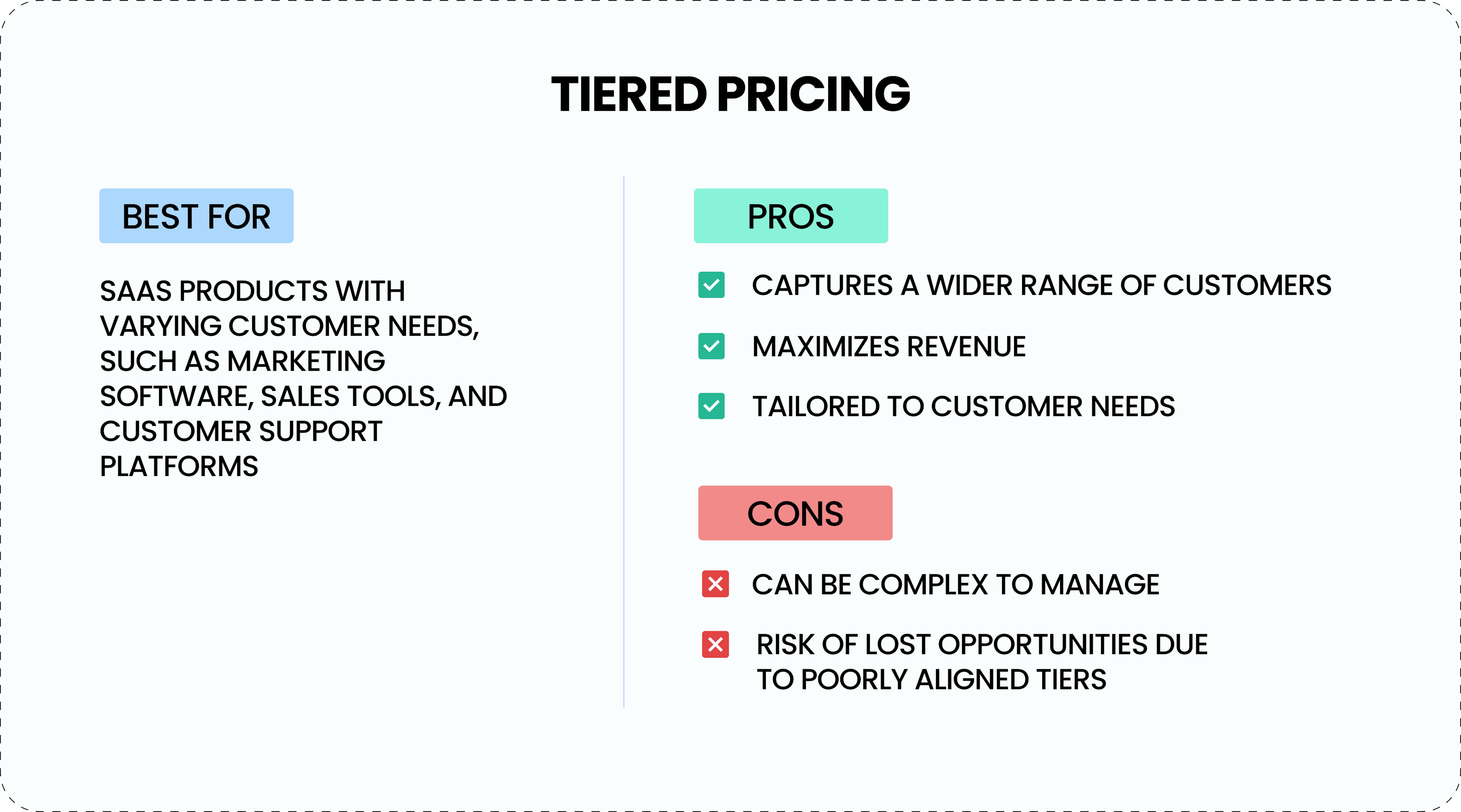
Freemium model
Customers can access a basic version of the product for free, with the option to upgrade to a paid plan for more features or higher usage limits.
Effectiveness:
The freemium model is effective for attracting a large user base quickly and converting a percentage of them into paying customers. However, it requires a careful balance between free and paid features to drive conversions.
A 2023 study by Databox showed that companies with a freemium model had a higher conversion rate when they offered clear value in the free version but reserved premium features for paid plans.
Successful example: In Dropbox users start with a free storage plan and can upgrade as their needs grow.
Pitfalls: Relying on freemium can lead to high acquisition costs with low conversion rates, especially if users find the free version sufficient. Additionally, supporting free users without generating revenue from them can strain customer service and infrastructure.
Best for SaaS products with a broad appeal that can provide value at both free and paid levels, such as communication tools, media services, and basic software utilities.
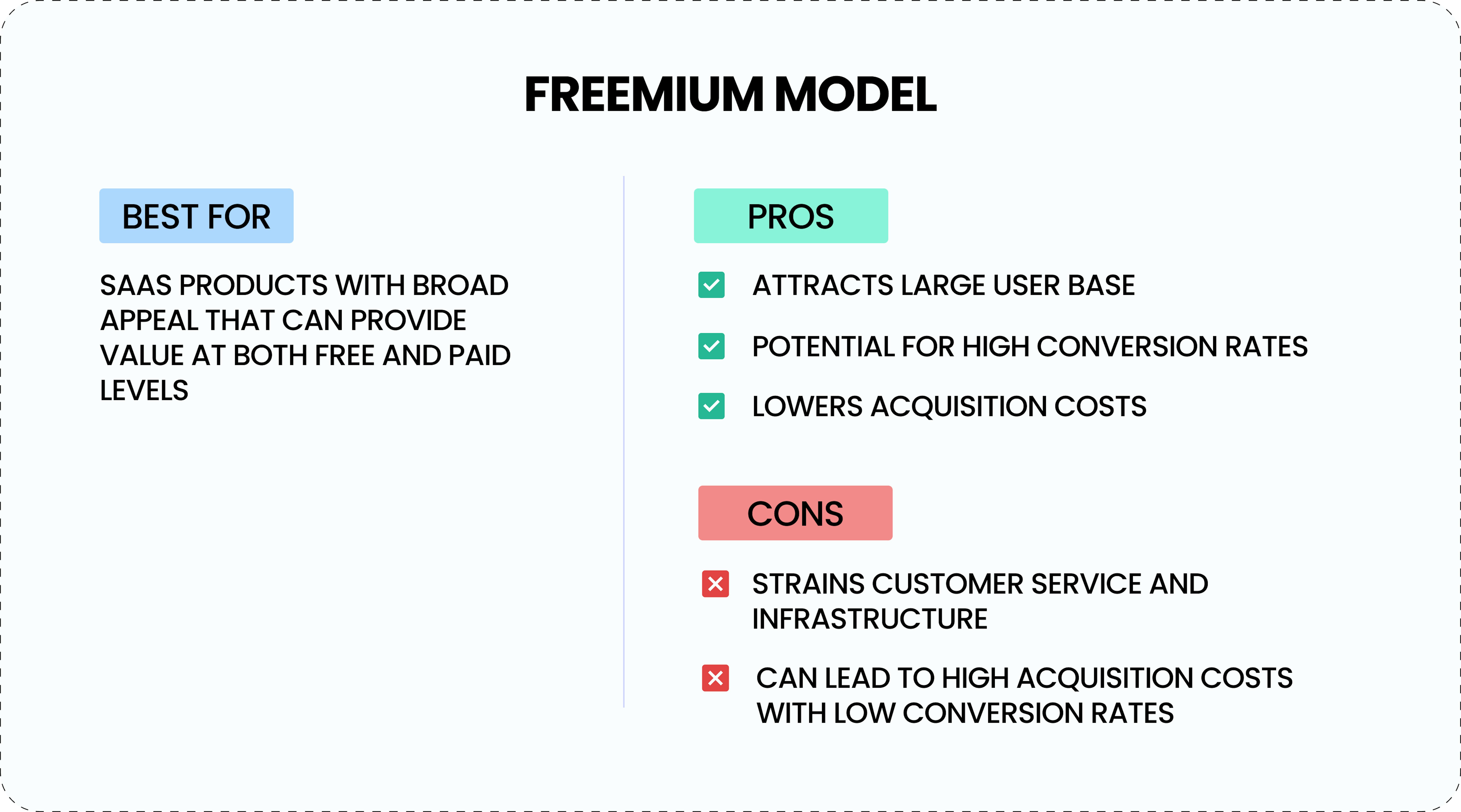
Per-user pricing
Customers are charged based on the number of users who have access to the product. This model is straightforward and scales with the customer’s organization.
Effectiveness:
Per-user pricing is easy to understand and manage, making it effective for products that are heavily dependent on individual usage. It aligns with the growth of the customer’s team, ensuring revenue scales with adoption.
The 2023 SaaS Benchmark Report noted that per-user pricing is popular in B2B SaaS, with 46% of companies employing this strategy.
Successful example: Slack applies per-active user pricing for some customers, billing only for users who actively used the platform within the month.
Pitfalls: Per-user pricing can be limiting for businesses looking to scale as it penalizes companies for adding more team members, which can slow adoption. It can also lead to churn if customers feel they are overpaying for inactive users.
Best for collaboration tools, project management software, and communication platforms where the value increases with the number of users, such as team-based software solutions.
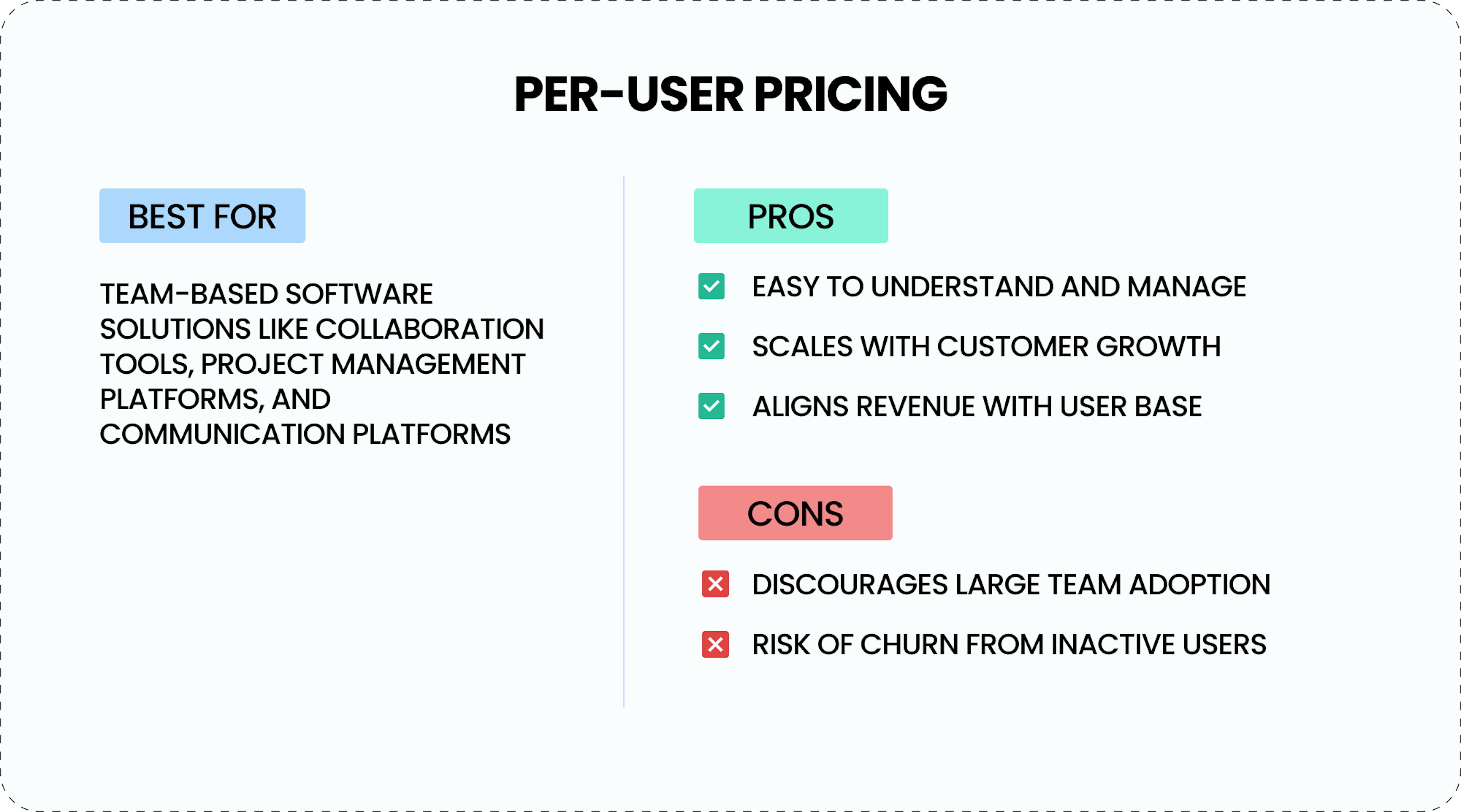
Per-feature pricing
Customers pay based on the specific features they use, allowing them to customize their plan according to their needs.
Effectiveness:
This model can be highly effective for products with a wide range of features that appeal to different user groups. It provides flexibility and allows customers to pay only for what they need. However, it can also become complex to manage and understand.
Research by ProfitWell in 2022 indicated that per-feature pricing could lead to higher customer satisfaction and lower churn if features are bundled strategically.
Successful example: Code Climate Velocity charges for add-on features, catering to teams with varied needs in analytics.
Pitfalls: Per-feature pricing can lead to a complicated pricing structure, making it harder for customers to understand the total cost. Additionally, there's a risk that customers will feel overwhelmed by too many options for each additional feature.
Best for SaaS products with a wide range of features and customer needs, such as CRM systems, business intelligence tools, and specialized software applications.

On-premise licensing
Customers install and run the software on their own servers instead of accessing it through the cloud, typically paying for a license with a recurring maintenance fee or through a hybrid subscription model. This pricing approach is ideal for enterprises that require more control over data and infrastructure.
Effectiveness: deal for customers who require more control over their data, security, or compliance and want to host software internally. SaaS companies targeting enterprises can use this model to meet the needs of clients who prefer on-premise solutions over cloud options.
Successful example: Enji.ai provide full control within your perimeter with lifetime support, including updates, bug fixes, and consultations.
Pitfalls: On-premise solutions can be complex and costlier for customers to manage, as they must handle infrastructure, maintenance, and upgrades, often requiring significant IT resources.
Best for: Organizations with strict compliance requirements, high-security needs. This model works well when customers already have a strong IT infrastructure capable of managing on-premise software.
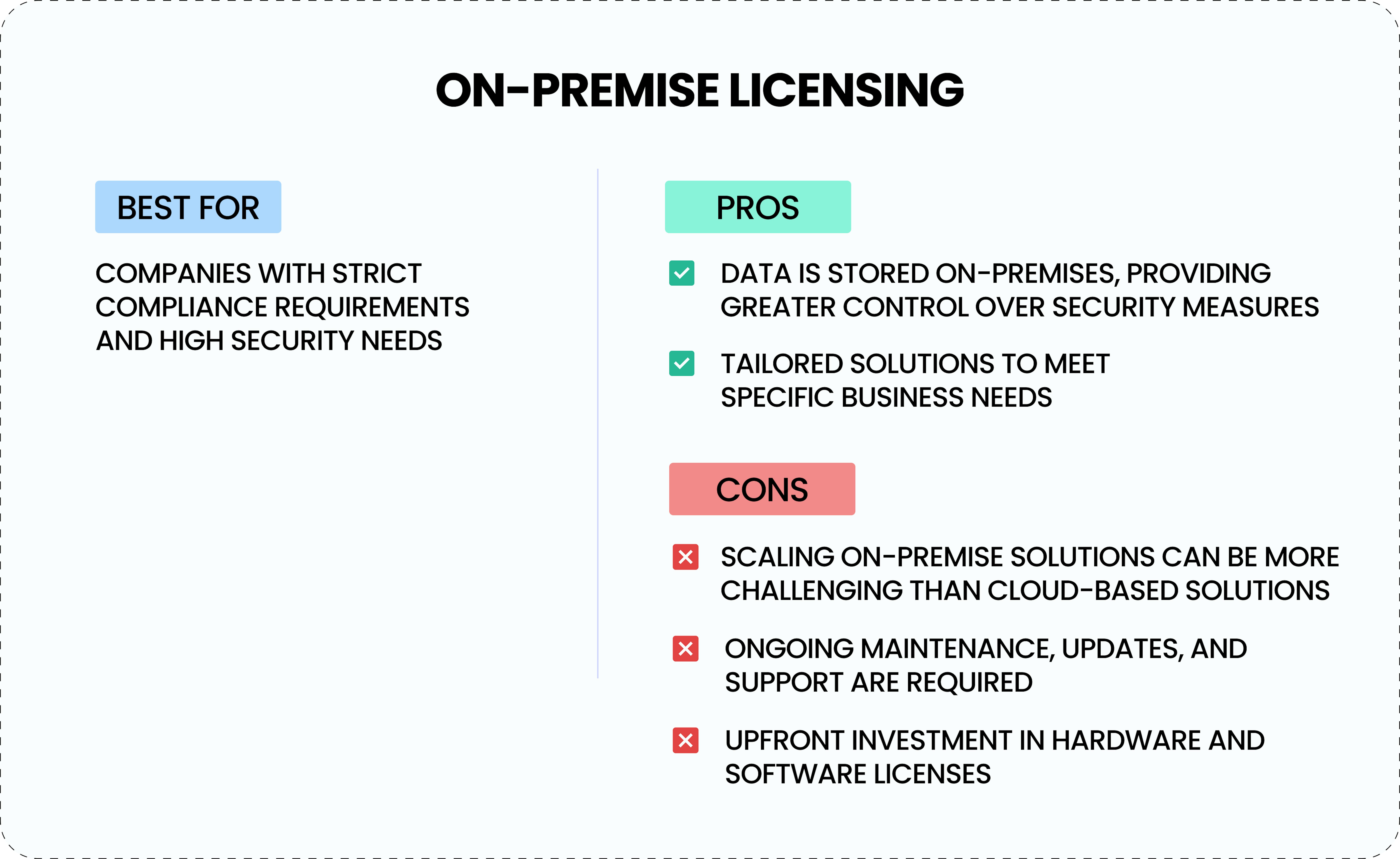
5 tips to choose the right SaaS pricing strategy
Choosing the right SaaS pricing strategy for a new product, especially when competing with established market leaders, requires careful analysis of both your product's unique value and the competitive landscape.
Below are key tips to help you make the right decision, with examples and transparent guidance on what to prioritize:
Tip 1. Understand your value proposition
Start by assessing what makes your product unique. What problems does it solve that your competitors might not address, or what features do you provide that add distinct value?
Key consideration: Focus on the unique benefits you offer. If you can demonstrate that your solution provides more efficiency or better results, customers may be willing to pay a premium.
Tip 2. Analyze competitor pricing models
Understanding how your competitors price their products will give you insights into potential opportunities for differentiation.
Key consideration: Offering a pricing model that gives customers more control over their spending, like usage-based or Per-Feature Pricing, can appeal to businesses that are hesitant about large upfront costs or fixed subscriptions.
Tip 3. Price for your target market
Understanding your target customers is critical in setting your pricing. Are you targeting small businesses with limited budgets or enterprise customers who are willing to pay more for advanced features?
Key consideration: Consider offering flexible pricing plans (e.g., Tiered Pricing) that scale with customer needs. This allows you to capture both budget-conscious users and larger clients looking for more robust solutions.
Tip 4. Leverage market gaps
If you notice a gap in the market—such as an underserved segment or a feature that competitors overlook—you can tailor your pricing to exploit this opportunity.
Key consideration: Identify what your competitors might be ignoring (smaller businesses, flexible pricing models) and craft your strategy to address those gaps.
Tip 5. Focus on customer acquisition first, then revenue
For a new product, growing your user base is often more important than maximizing revenue from day one. Pricing competitively or offering flexible options can help you build market share.
Key consideration: Don't shy away from offering lower introductory pricing or a free trial. Once your product gains traction and loyalty, you can gradually introduce premium features and price increases.
To wrap up
Ultimately, the right pricing strategy for a new product depends on several factors: the uniqueness of your value proposition, your target market, competitive landscape, and your long-term goals. It's often helpful to start with a flexible approach, offer lower entry points or free trials to attract users, and then build on that foundation as your product gains traction.
If you're competing against well-established leaders, differentiating through pricing models (e.g., usage-based if they offer subscriptions) or focusing on underserved market segments will give you the edge. Ultimately, your pricing should reflect your product's value, while being flexible enough to adapt as your business evolves.
Ready to explore the best pricing strategy for your product? Schedule a free consultation with Mad Devs to discuss your specific needs and goals. Our experts can help you develop a pricing model that drives growth and maximizes revenue.
